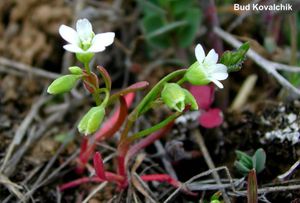Difference between revisions of "Montia linearis"
m (Tag: VisualEditor) |
(Tag: VisualEditor) |
||
| Line 1: | Line 1: | ||
* Latin Name: ''Montia'' ''linearis'' | * Latin Name: ''Montia'' ''linearis'' | ||
* Family: Portulacaceae | * Family: Portulacaceae | ||
| − | * Common Names: lineleaf | + | * Common Names: lineleaf miner's lettuce, narrow-leafed montia |
* Synonyms/Misapplications: ''Clatyonia'' ''linearis'' | * Synonyms/Misapplications: ''Clatyonia'' ''linearis'' | ||
* Codon: MONLIN | * Codon: MONLIN | ||
| Line 32: | Line 32: | ||
Corolla is white, petals 5, white, 4-6 mm. long, sepals 2. | Corolla is white, petals 5, white, 4-6 mm. long, sepals 2. | ||
| − | Fruits are 3-valved capsules, bearing shiny, black, lens-shaped seeds.<ref>Klinkenberg, Brian. (Editor) 2020. ''E-Flora BC: Electronic | + | Fruits are 3-valved capsules, bearing shiny, black, lens-shaped seeds.<ref>Klinkenberg, Brian. (Editor) 2020. ''E-Flora BC: Electronic'' |
| − | Atlas of the Plants of British Columbia'' [eflora.bc.ca]. Lab for Advanced | + | Atlas of the Plants of British Columbia'' [eflora.bc.ca]. Lab for Advanced'' |
Spatial Analysis, Department of Geography, University of British Columbia, | Spatial Analysis, Department of Geography, University of British Columbia, | ||
Vancouver. [Accessed:2020-05-09]</ref> | Vancouver. [Accessed:2020-05-09]</ref> | ||
Revision as of 14:42, 4 June 2020
- Latin Name: Montia linearis
- Family: Portulacaceae
- Common Names: lineleaf miner's lettuce, narrow-leafed montia
- Synonyms/Misapplications: Clatyonia linearis
- Codon: MONLIN
Contents
Taxonomy
| Montia linearis | |
|---|---|

| |
| photo by Bernard Kovalchik, also featured on Main Page | |
| Scientific classification | |
| Kingdom: | Plantae |
| Subkingdom: | Tracheobionta |
| Phylum: | Spermatophyta |
| Subphylum: | Magnoliophyta |
| Class: | Magnoliopsida |
| Subclass: | Caryophyllidae |
| Order: | Caryophyllales |
| Family: | Portulacaceae |
| Genus: | Montia L. |
| Species: | Montia linearis (Douglas ex Hook.) Greene |
Description
Annual herb from a fibrous root; stems ascending to erect, usually solitary but sometimes several, branched or unbranched, 5-20 cm tall.
Basal leaves lacking; stem leaves several, leaves are alternate throughout and narrow.
Inflorescence consists of loose terminal or axillary racemes, bearing 5-12 flowers on slightly recurved stalks.
Corolla is white, petals 5, white, 4-6 mm. long, sepals 2.
Fruits are 3-valved capsules, bearing shiny, black, lens-shaped seeds.[1]
Bloom Period
April - July. [2]
Distribution
From British Columbia, east to Saskatchewan, south along the west coast of the United States to Southern California, and is also present in some states in the south eastern United States. [3]
Habitat
Moist to dry habitats in lowland to foothills.[4]
Seed
Seed sample from: 2011
Average Measurement: 2.2 x 2.2 x 1
Measurement Range: L: 2 - 2.5, W: 2 - 2.5, D: 0.9 - 1.1
Features
Shape: Seed lenticular in shape.
Color: Hilum scar is white, surrounded by a ring of brown. Seed is dark red to black.
Surface: Seeds are papillose with some small ridges around the surface edges.
Could be confused with: Caladrinia ciliata
Latitudinal Cross Section: : rhombic ![]()
Longitudinal Cross Section: elliptical ![]()
Basic Explanations and Assumptions:
The dimensions for the seeds are length x width x depth. The location of the hilum is used as the base of the seed, and the length is measured from hilum to the opposite apex. Where a style is present, the length is measured from the hilum to the bottom of the style. Width is measured at a right angle to the length at the widest part. Depth is measured at a right angle to the intersection of height and width lines.
Measurements included are the mean average for each measurement of ten separate seeds.
All measurements in millimeters unless otherwise noted.
Photo Gallery
References
- ↑ Klinkenberg, Brian. (Editor) 2020. E-Flora BC: Electronic Atlas of the Plants of British Columbia [eflora.bc.ca]. Lab for Advanced Spatial Analysis, Department of Geography, University of British Columbia, Vancouver. [Accessed:2020-05-09]
- ↑ WTU Herbarium, Burke Museum, & University of Washington. Retrieved from https://biology.burke.washington.edu/herbarium/imagecollection/taxon.php?Taxon=Montia%20linearis
- ↑ USDA, NRCS. 2012. The PLANTS Database (http://plants.usda.gov, 16 April 2012). National Plant Data Team, Greensboro, NC 27401-4901 USA.
- ↑ Hitchcock, C. L., Cronquist, A., Giblin, D., & Legler, B. et al. (2018). Flora of the Pacific Northwest: an illustrated manual. Seattle: University of Washington Press.




